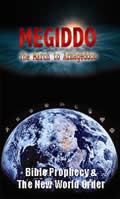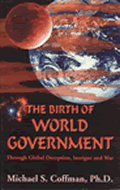UNDERSTANDING AMERICA'S
FINANCIAL CRISES
PART 4
By
Michael S. Coffman, Ph.D. and Kristie Pelletier
June 2, 2011
NewsWithViews.com
The entire global economy is collapsing. A new global financial architecture has been developing in the wings to implement in case of just such a catastrophe. It is part of a plan that has been in the works for a hundred years.
In Part III we discussed the insane, seemingly deliberate, collapse of the American and European economies. The collapse could be nothing more than the natural outcome of a destructive ideology using an equally bankrupt Keynesian theory of economics. However, there is strong evidence that the entire collapse is the result of a century old plan to create a world government with a single monetary system. Today it goes under the name of global governance.[1]
The problem globalists have always faced is how to get the citizens of the world to adopt such a radical plan if the economies of the various nations are healthy and vibrant. The easiest way, of course, is to crash the global economy so that desperate and fearful citizens would clamor for someone to rescue them. The globalists could then ride in on their white horses with a complex global plan that will allegedly save the world.
Kings, rulers and despots have used fear since the beginning of time to unite people behind them. Usually the fear de jour has been the threat of war. This time, however, it is the real threat of financial ruin, even starvation in some cases. It is significant that Robert Zoellick, President of the World Bank, and one of the top globalists in the world, warned attendees at the World Bank/International Monetary Fund (IMF) meeting in Washington DC on April 17 that rising food prices have put the poor in the world “one shock away from a full-blown crisis.”
The rapidly growing national debt crisis explained in Parts I, II and III is only one component of the triple threat of total economic collapse. Another threat is the increasing cacophonous call for abandoning the dollar as the world’s reserve currency. The third is the politically created dependence on foreign oil that is causing the skyrocketing gasoline and diesel costs.
As explained in Part II, if the U.S. dollar loses its reserve status, the trillions of dollars circulating in the world today would suddenly be dumped back into the United States. This would likely make the dollar worthless and light the fuse to hyperinflation. Knowing that this might happen is one thing. But, is there any evidence that there is a concerted effort to remove the dollar as the reserve currency? Unfortunately, the answer is yes.
The Systematic Attack on the U.S. Dollar
The U.S. has historically fought off efforts to remove the dollar as the reserve currency. However, the systematic debauching of the U.S. dollar by the Fed, Bush and now Obama’s deficit spending, has caused instability in the world and a flurry of demands to do just that.
For instance, the IMF issued a report in February suggesting a possible replacement of the dollar as the world’s reserve currency. The IMF recommended that Special Drawing Rights (SDRs) be implemented which would establish an exchange rate based on a weighted basket of international currencies. The net result would be that the dollar would lose its status as the world’s sole reserve currency.
The IMF recommendation was immediately supported by the G20 meeting at the end of March. During that meeting China emphatically called for the end to the dollar’s use as the world’s reserve currency. The next attack on the dollar occurred just before theWorld Bank/IMF meeting in mid-April. Joseph Stiglitz, former vice president of the World Bank and Nobel Prize winner, called for a “global system” to replace the dollar as a reserve.
Simultaneous to the World Bank/IMF meeting in April, George Soros held a conference labeled Bretton Woods II International to agitate for a one-world currency. The name is meant to play off of the 1944 BrettonWoods conference that led to the creation of the World Bank and International Monetary Fund (IMF). Soros spent $50 million to bring in 200 experts to explore “establishing new international rules” and reformation of the “currency system.”
Soros has long demanded that the U.S. dollar be removed as the world’s reserve currency to be replaced preferably by a global currency within a “multilateral world.” To do that, America must be brought down. Soros believes he is just the man to do it. After all, he has broken the Bank of England as well as the economies of several other sovereign nations.
These examples are but a small sampling of the growing effort to terminate the dollar as the world’s reserve currency. If the efforts are ever successful, it would have a devastating impact on every American. Yet, the media is strangely silent on this growing threat. We are being told by our leaders and the media this will never happen in America. No need to worry or prepare. After all, the Royal wedding of Prince William and KateMiddleton is of far greater importance.
The Politically Created Dependence on Foreign Oil
While our attention is being diverted to non-critical spectacles, there is a third threat that could destroy our economy; one that has been created entirely by politics. A very real possibility exists that oil could make a leap to $200 a barrel which would push average gasoline costs well over $6 per gallon. While no one knows for sure, analysts have speculated that $5 is the breaking point to push America into a depression.
The instability in the Mideast and the inflation/devaluation of the dollar[a] has already increased oil and gasoline prices by over 20 percent from the end of January to Mid-April. Gasoline prices are currently pushing four dollars a gallon and some analysts speculate it could reach $5/gallon this summer. All it would take to push gas price over $5/gallon at the pump is a further devaluation of the dollar (making foreign oil more expensive) and/or Saudi Arabia becoming embroiled the protests and revolutions currently gripping the Mideast.
With Mideast crises spreading to Saudi Arabia well within the realm of possibility, oil analysts are stunned by Obama’s claim that he is doing all that he can to issue new domestic drilling permits. The truth is just the opposite; the Obama administration is doing all it can to deny drilling permits. His administration has even ignored a court ruling to reinstate deep water drilling permits that Obama had banned. It wasn’t until the court ruled the Obama administration in contempt of court on February 2 that drilling permits started to dribble out again.
America’s extreme vulnerability to instability in the Mideast is entirely politically contrived. Not only has the administration thrown roadblock after roadblock in the path of off-shore drilling, but progressives in Congress have systematically blocked every effort to tap into Anwar in northern Alaska and the oil shale of Wyoming, Utah and Colorado. Their constant mantra is that drilling causes unacceptable environmental damage. If that doesn’t fly because the facts contradict that red herring, progressives then trot out the excuse that it takes 10 years for drilling to start producing oil, so it won’t help today.
The claim it takes 10 years for new drilling permits to actually start producing oil is another red herring. Had drilling permits in Anwar been issued in 2000, as President G. W. Bush wanted, those wells would now be producing and we would not be as vulnerable to the Mideast crisis. Additionally, new technology has allowed drilling without damage to the environment. The drilling footprint in Anwar’s Arctic National Wildlife Refuge would be about as significant as the alleged $38.5 billion budget cut Republican’s exacted out of Obama’s $1.65 trillion deficit in 2011. Neither have any importance.
The oil shale deposits alone represent the largest supplies of oil and natural gas in the world. There is absolutely no need for the U.S. to be so vulnerable to the instability in the Mideast. Even better, domestic oil production would be somewhat immune from a devalued dollar since domestic oil is produced using the same dollar by which it is sold. An even bigger plus is that we keep our dollars within our borders rather than sending nearly $500 billion a year to nations that typically hate us.
Political policy, not supply and demand, has made the U.S. progressively more dependent on expensive foreign oil. Our dependence on foreign oil is further exacerbated by the fact that oil companies are going to drill where it financially expedient to do so. Like so many other industries, oil is being regulated out of business in America. If it costs $40 to produce a barrel of oil in North Dakota and $20 in Nigeria, oil companies are going to set up shop in Nigeria, all other factors being equal.
Oil companies are the first to get blamed when gas prices skyrocket and the companies make billions of dollars in profits. Exxon made a whopping $11 billion the first quarter of 2011, which is a lot. However, out of an average $3.60 a gallon of gas at the pump during the first quarter, Exxon’s Vice President Ken Cohen claimed their profit was only $0.07. Should we get mad at Exxon, or should we get mad at the government who made $0.40 to $0.60 in taxes on the same gallon? More significant, most of Exxon’s profits were from overseas.
Most people don’t realize oil profits are so small. The profit margin of the oil industry in 2008 year was 9.7 percent. The average for the S&P 500 is 8.5 percent. The same is true for 2011. Most years the profit margins for big oil are smaller than the average. The reason their profits seem excessive is not because they are ripping off the public – at least not as a rule – but is because these companies are huge. A thin profit margin adds up to big bucks.
What is of much greater concern than huge profits is that it is simply becoming too complicated and expensive to do business in the U.S., and it is becoming impossible to keep a wide enough profit margin. The progressives continue to do everything they can to vilify the oil companies or blame speculators. There is absolutely no evidence of manipulation this time by either. However, by blaming oil companies and speculators so, they divert attention from the fact that they are legislating domestic energy companies right out of business.
Are all these potential disasters to America a coincidence due to ineptness and ideology, or are they planned? If they are deliberate, there must be a global plan in the wings to take over when the current system fails. The question then becomes, is there a plan for a new global financial architecture? Unfortunately, the answer is yes.
The New Global Financial Architecture
On January 21, 1999, the UN issued a new report entitled, Towards a New International Financial Architecture (IFA). While the report focuses on correcting many global financial deficiencies of the day, “The recent [Asian] crisis has demonstrated a fundamental problem in the global economy,” asserts the IFA. The primary cause of the global crisis, alleges the report, is “the enormous discrepancy that exists between an increasingly sophisticated and dynamic international financial world, with rapid globalization of financial portfolios, and the lack of a proper institutional framework to regulate it.” (Bold original) The same dialogue exists in 2011.
The IFA plan is to “create a world financial authority...in charge of setting the necessary international standards for financial regulation and supervision, and of supervising their adoption at the national level.” All of this would be administered through “a network of regional and subregional organizations to support the management of monetary and financial issues.” Individual economic regions would operate under a strengthened UN Economic and Social Council or newly created Economic Security Council. The new institution would establish and manage global macroeconomic policy and the regions and subregions would implement the policy.
The IFA is designed to overcome the failings of a single, global financial/trade structure like the WTO by using regional institutions patterned after the European Union. G.W. Bush’s Security and Prosperity Partnership of North American (SPP) in 2005 was an initial effort to do just that. Tagged the North American Union (NAU) by critics, strong opposition caused the effort to fail by the end of Bush’s term. Since economic regions are to be the heart of the new global financial architecture, it is not surprising that President Obama is continuing the dialogue with Canada and Mexico, albeit on a much lower key.
Within this structure, the International Monetary Fund (IMF) would be restructured so that it would increasingly serve as “a world central bank.” A world central bank “would require, in particular, the surrender of more economic autonomy and powers of intervention in national policies than countries are willing to accept at present.”
The emerging financial architecture was formalized at the UN’s March, 2002 International Conference on Financing for Development in Monterrey Mexico. Supporting documents called on The Bank for International Settlements (BIS) to work closely with individual nations and the UN to restructure the global financial architecture.
The Monterrey Conference tasked IMF and the BIS through the BIS’ Financial Stability Forum (now the Financial Stability Board) with strong oversight responsibilities of the financial dealings of every nation, including the United States. To do this required that the records of every nation to be open to the IMF and BIS, and ultimately the UN. By doing so, the IMF and BIS could control the world at the international level.[2] Their goals include dividing the world into economic regions patterned after the European Union.
Could this happen to the United States? It already has. The Financial Reform Act of 2010 gave sweeping new oversight powers to the Federal Reserve to do just about everything laid out in the Monterrey Conference. Most people miss the connection because they believe the Federal Reserve (The Fed) is part of the federal government under the control of Congress. It is not. It is a private corporation completely removed by law from Congressional oversight. It is America’s Central Bank, which, along with the Bank of England, also controls the IMF and BIS. Nice and tidy. This stunning betrayal of every American was done completely by the progressive Democrats in Congress.
Most people find it incredible that this plan has been underway for nearly a century. Carroll Quigley, the foremost Harvard/Georgetown University historian of the Twentieth century, had worked with this cabal of globalists for twenty years, and had access to their records for two years. In his 1966 book Tragedy and Hope, he spelled out what the cabal was going to do in the next 50 years:
The powers of financial capitalism had another farreaching aim, nothing less than to create a world system of financial control in private hands able to dominate the political system of each country and the economy of the world as a whole. This system was to be controlled in a feudalist fashion by the central banks of the world acting in concert by secret agreements arrived at in frequent private meetings and conferences. The apex of the system was to be the Bank for International Settlements in Basel, Switzerland, a private bank owned and controlled by the world’s central banks which were themselves private corporations. [3] (Italics added)
Quigley details the financial and political exploits of this small cartel of globalists to manipulate national and global events to their own advantage. He claims this cartel even controls the Fed, the privately controlled central bank in the United States. It is nothing less than nouveau financial imperialism and has very little to do with true capitalism and even less to do with free markets.
Quigley goes on to say, “this group is…one of the most important historical facts of the twentieth century.”[4] The actions of this group have benefited only themselves, not the world’s citizens, and certainly not American citizens. Quigley notes that the efforts of the group have “been a disaster to our way of life.”[5]
Once the dollar collapses as is probable if current and future deficits are not eliminated, and if we don’t make securing domestic oil the priority of the nation, the disaster Quigley noted in the past will be a walk in the park compared to what is coming. Forty-four years after he penned these words, all that he predicted is coming true.
| Subscribe to the NewsWithViews Daily News Alerts! |
Is it too late? No. The mess we are currently in was created or allowed by the progressives on both sides of the isle and at every level of government. Therefore, the first step is to replace these progressives currently in office with those who are committed to upholding the Constitution of the United States. We have to vote them out, and get rid of the non-elected entities from Washington who have gotten us into this mess. For that to happen, everyone who now understands what is happening must share their knowledge with friends, family and coworkers. Volunteer to run for office yourself. Failing that, support candidates who are dedicated to stopping this agenda with your time and finances. The ballot box revolution started in 2010. It must reach critical mass in 2012 to sustain the momentum in the decades ahead.










 Share
This Article
Share
This Article



